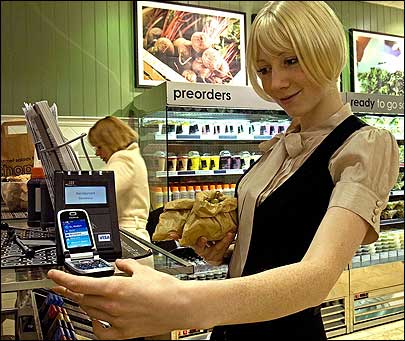Sep 04, 2008In late 2007, British cellular service provider O2 UK launched a six-month technology trial to gauge consumer interest in and comfort with using RFID-enabled mobile phones to make fare payments to access the London subway, pay for goods at select retailers and access information over an Internet connection. The results are now available, says Claire Maslen, head of O2's Near Field Communication (NFC) department, and they are encouraging.
O2 brought together a number of vendors to convene the trial, including handset manufacturer Nokia, which provided its 6131 phone to the 500 trial participants. The phone includes an NFC module, which employs a standard 13.56 MHz passive RFID protocol to carry out its payment and data-collection functions (see O2 Subscribers Use Phones to Make Purchases, Access Info).

Responding to a post-trial survey, 78 percent of participants indicated that based on their experience using the Nokia phone, they would consider partaking in NFC-based services made available through their cell phone provider. But enthusiasm for the payment function, Maslen says, was stronger among the 275 participants whose test phones could be utilized only for making subway fare payments, than it was for the 225 whose phones also carried the Visa payWave application for making contactless debit card payments at select retailers outfitted with RFID interrogators. The weaker interest among the payWave subset, she notes, could be due to their hesitancy to embrace a new approach to making payments.
"Consumers here have been told to use PIN-and-chip payments for so many years," Maslen explains, "and then contactless [RFID-based] cards were introduced, and now they have contactless on their mobile. I think the lower percentage has to do with confidence levels and what we are used to using. Here, using the Oyster [contactless] card is second nature; if you use a paper ticket to get on the Tube, people look at you funny."
In other words, consumers are used to the approach of holding an RFID-based Oyster payment card up to a turnstile in order to enter the subway system—in fact, more than 10 million British consumers currently use Oyster cards. The trial participants were much more at ease with the concept of holding their mobile phones up to the reader embedded in the turnstiles, Maslen says, compared with the idea of using their phones to make payments at merchant locations, where consumer are accustomed to swiping the magnetic stripe on their debit cards, then keying in a code to authenticate the purchase.
But consumers in the United Kingdom are slowly getting used to employing RFID-based cards such as Visa' payWave, she says, and familiarity with those cards will make them more comfortable using their mobile phones in the same manner. "If we did this trial in a year's time, that figure of 47 percent interest could increase," she predicts.
Participants were also issued RFID tags embedded in stickers that they could utilize as a type of digital sticky note. They could encode the URL of a real-time train schedule, for instance, and adhere the sticker to their desk at work. When preparing to leave for home, they could then read the sticker's tag with their phone and call up the current train schedule on their phone's Web browser. Smart posters, which have RFID tags embedded in them that can be used similarly, were offered as well.
"The smart posters were really well received, and in hindsight, we wish we'd done more," Maslen states. "It's so intuitive for someone to 'tap' their phone against a tag. No need for fancy cameras or complicated settings! We've subsequently used some of the smart-poster ideas internally, and at events, to test people's views, and it's always a positive reaction. We're working with tag providers to ensure we have a variety of tags available in different formats, and that work in different environments (behind glass, on metal, etc.)."
O2's next step will be to gather together a task force consisting of vendors involved in the trial, as well as additional handset manufacturers, banks and other vested parties, and to work on architecting subsequent stages. "We hope to meet starting in October or November, and we are open to different vendors stepping in," Maslen says. "In the U.K., we have 14 different train operators that come into London, and we want to work with them as well. We also have a few major card schemes [payment card organizations]." There are many opportunities to grow a large NFC payment infrastructure in the United Kingdom, she explains.
But buy-in from other handset manufacturers will be key to the technology's success, since O2 is thus far working with only one phone maker—Nokia—on NFC. "We have close relationships with all of the tier-one handset manufacturers," Maslen says, "and we hope they will join our task force so we can move forward."
Some issues O2 will address as it decides its next steps will be those raised by participants. In addition to wanting a selection of different NFC handsets to choose from, those involved in the trial expressed interest in an improved user interface that would allow them to manage their Oyster and payWave accounts through their phones. In terms of payments security, participants indicated that while they would appreciate using a personal identification number to authenticate payments on a periodic basis, they did not want to have to key in a PIN for every transaction.

